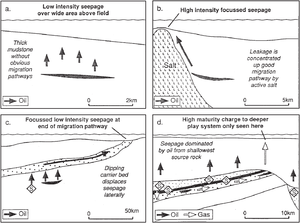Surface geochemical exploration: assumptions
| Exploring for Oil and Gas Traps | |

| |
| Series | Treatise in Petroleum Geology |
|---|---|
| Part | Predicting the occurrence of oil and gas traps |
| Chapter | Surface geochemical exploration for petroleum |
| Author | Dietmar Schumacher |
| Link | Web page |
| Store | AAPG Store |
Traps leak
The underlying assumption of all near-surface geochemical exploration techniques is that hydrocarbons are generated and/or trapped at depth and leak in varying but detectable quantities to the surface. This has long been established as fact, and the close association of surface geochemical anomalies with faults and fractures is well known.[1][2][3][4] The surface expression of hydrocarbon seeps is best developed in areas with numerous well-developed migration pathways and an active petroleum system.

Anomalies relate to traps
A further assumption is that the anomaly at the surface can be related reliably to a petroleum accumulation at depth. The success with which this can be done is greatest in areas of relatively simple geology and becomes increasingly difficult as the geology becomes more complex. The geochemical or microbial anomaly at the surface represents the end of a petroleum migration pathway, a pathway that can range from short-distance vertical migration at one end of the spectrum to long-distance lateral migration at the other extreme.[5] Relationships between surface geochemical anomalies and subsurface accumulations can be complex; proper interpretation requires integrating seepage data with geological, geophysical, and hydrologic data. Understanding geology—and, hence, petroleum dynamics—is the key to using seepage data in exploration.
Seepage styles
Figure 1 shows examples of contrasting seepage styles and migration pathways from the Gulf of Mexico and the North Sea.
See also
- Principles of surface geochemical exploration
- Limitations and uncertainties of surficial gechemistry
- Seepage activity and surficial geochemistry
- Macroseepage vs. microseepage in surficial geochemistry
- Geochemical surface expression
References
- ↑ Horvitz, L., 1939, On geochemical prospecting: Geophysics, vol. 4, p. 210–228, doi: 10.1190/1.1440497
- ↑ Horvitz, L., 1969, Hydrocarbon prospecting after thirty years, in Heroy, W., B., ed., Unconventional Methods in Exploration for Petroleum and Natural Gas: Dallas, Southern Methodist Univ. Press, p. 205–218.
- ↑ Jones, V., T., Drozd, R., J., 1983, Predictions of oil or gas potential by near-surface geochemistry: AAPG Bulletin, vol. 67, p. 932–952.
- ↑ Price, L. C., 1986, A critical overview and proposed working model of surface geochemical exploration, in Davidson, M. J., ed., Unconventional Methods in Exploration for Petroleum and Natural Gas IV: Dallas, Texas, Southern Methodist Univ. Press, p. 81–129.
- ↑ 5.0 5.1 Thrasher, J., A., Fleet, A., J., Hay, S., J., Hovland, M., Duppenbecker, S., 1996, Understanding geology as the key to using seepage in exploration: the spectrum of seepage styles, in Schumacher, D., Abrams, M., A., eds., Hydrocarbon Migration and Its Near-Surface Expression: AAPG Memoir 66, p. 223–241.